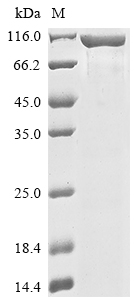To express the recombinant Human HAVCR1 protein in mammalian cells, a DNA fragment encoding the Human HAVCR1 protein (21-290aa) is inserted into a plasmid vector and transferred to the mammalian cells. Cells containing the plasmid are screened, cultured, and induced to express the HAVCR1 protein. The protein carries a C-terminal hFc-Myc tag. Lysing the cells allows for the collection of the recombinant Human HAVCR1 protein, which is purified through affinity purification and then identified through SDS-PAGE and subsequent staining of the gel with Coomassie Brilliant Blue. The purity of the recombinant Human HAVCR1 protein obtained is greater than 85%.




